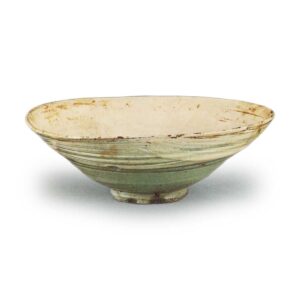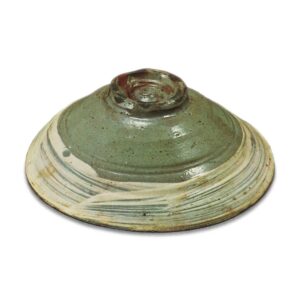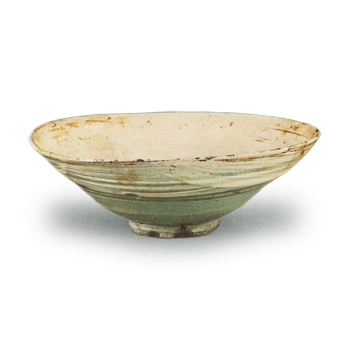

Height: 5.4 – 5.9 cm
Diameter: 16.6 – 17.0 cm
Outer diameter of foot ring: 5.0 cm
Height of foot ring: 0.8 – 1.0 cm
This is a thin, slightly large, bright-looking tea bowl with a brush pattern. It is not marked with a signature. The overall impression is of a simple, uncomplicated tea bowl, and its refreshing quality is its charm. The wheel-formed shape is light and airy, and the bowl is thin from the foot to the rim, showing a slight distortion at the rim that gives it a comfortable, expansive feel. Even though it is a flat bowl, it is not shallow, but rather has a wide, generous interior. There are two clearly defined lines of concave lines around the outside of the body, and the surface that extends to the rim is almost flat, while the surface that extends to the foot of the bowl shows a beautiful bulge. The fast turning of the potter’s wheel and the casual treatment of the surface have given rise to this gentle, taut shape. The foot ring is also beautifully carved. The bamboo node foot ring is sharply defined, and the inside of the foot ring has sharp whorl marks. The center is shaped like a helmet, but the tip is pressed down with the fingertips, and it is unusual that it is rounded off. There is a small fire mark on part of the foot ring, and only that part is a reddish brown color. This is probably the mark left by the fingertips when the glaze was applied. This shows that the clay is dense and contains a considerable amount of iron, and that it has been fired hard. By applying a white slip to this type of clay, a pure white pottery is produced, and this is called “kohiki” or “muji-hake”. The brush marks are nothing more than the transformation of this self-glaze.
In this teacup, the brush marks are applied to the entire inside and half of the outside, and a transparent overglaze is applied all over the surface of the vessel. On the outside in particular, the clay color of the base material clearly shows through the overglaze in a grayish blue, enhancing the white brush marks even more. The brush marks are made by dipping a large brush into a pot of white clay and then moving it in a single or double circular motion, leaving brush marks that run vigorously across the surface. In contrast, the inside of the bowl is full of large brush marks in the shape of a swastika, and the thick layer of white clay covers the entire surface, with the clay showing through in two or three sharp lines. And on the so-called “mirror” at the bottom, there are six dark brown traces of sanding. These brush strokes are a magnificent pattern in themselves, and it could be said that this simple, expertly designed pattern is more suitable for a tea bowl. In addition to the red kiln marks, there are also dark pink spots on the underside of the foot ring. In addition to these, there are also dark sand-like marks and crescent-shaped cracks – these are cracks that run through the inside and outside of the bowl – and various other interesting features can be seen on the foot of the bowl, making this a very unusual piece. This is one of the highlights of this bowl.
Together with other Mishima-te, brush marks are produced in kilns throughout the southern region of Korea, and the Mishima-te from the Gyeryongsan kilns in Chungcheongnam-do is particularly renowned for its excellence. This tea bowl is also strongly made, and the light and vivid brush marks suggest that it may have been made at the Gyeryongsan kiln, but there are also points on the body and foot that make it difficult to be certain, so we will leave this as a question for the time being.
It was passed down in the Asada family of Kanda Surugadai, Tokyo, and was a particularly prized possession of the late Tokunori Asada. In 1934, it was designated as an Important Art Object, and later, when the family sold off their possessions, it came into the possession of the tea utensil dealer Sōzaburō Ikedo of Osaka, and is now in the collection of a certain Osaka family.



